There are many reasons why your past customers stopped buying from you.
Maybe they only bought something from you as a gift the first time. Perhaps your product mix has changed. Maybe they bought your products because of a promotion.
Whatever the reason, they’re gone. Unless you do something, these customers may never buy from you again.
It’s time for an intervention, and that comes in the form of a win-back campaign: a series of communications that bring inactive customers back to making regular purchases. Here’s how to use them to drive revenue.
What are win-back campaigns?
Win-back campaigns are a series of emails, texts, or notifications designed to reengage a previous customer.
If somebody hasn’t purchased in six months, for example, a win-back email campaign (also known as a reactivation campaign) increases the likelihood of them returning to buy again—rather than losing them forever.
Benefits of running win-back campaigns
Are you continually trying to acquire new customers but frustrated by the associated costs? The return on advertising spend has been on a downward trend since the end of the lockdown period, with the cost per thousand ad impressions (CPMs) experiencing a noticeable increase year over year.
Regular income is vital if you want to stay in business. So you can’t keep churning and burning customers.
Data shows acquiring new customers can be as much as five times more expensive than retaining the ones you already have. And while repeat customers account for just over a fifth of a brand’s customer base, they generate 44% of total revenue and 46% of all orders.
These numbers make a case for having a stellar win-back campaign, and crucially, activating previous customers to buy from you again. In the end, it’ll save you money and help grow your existing customers’ spend over time.
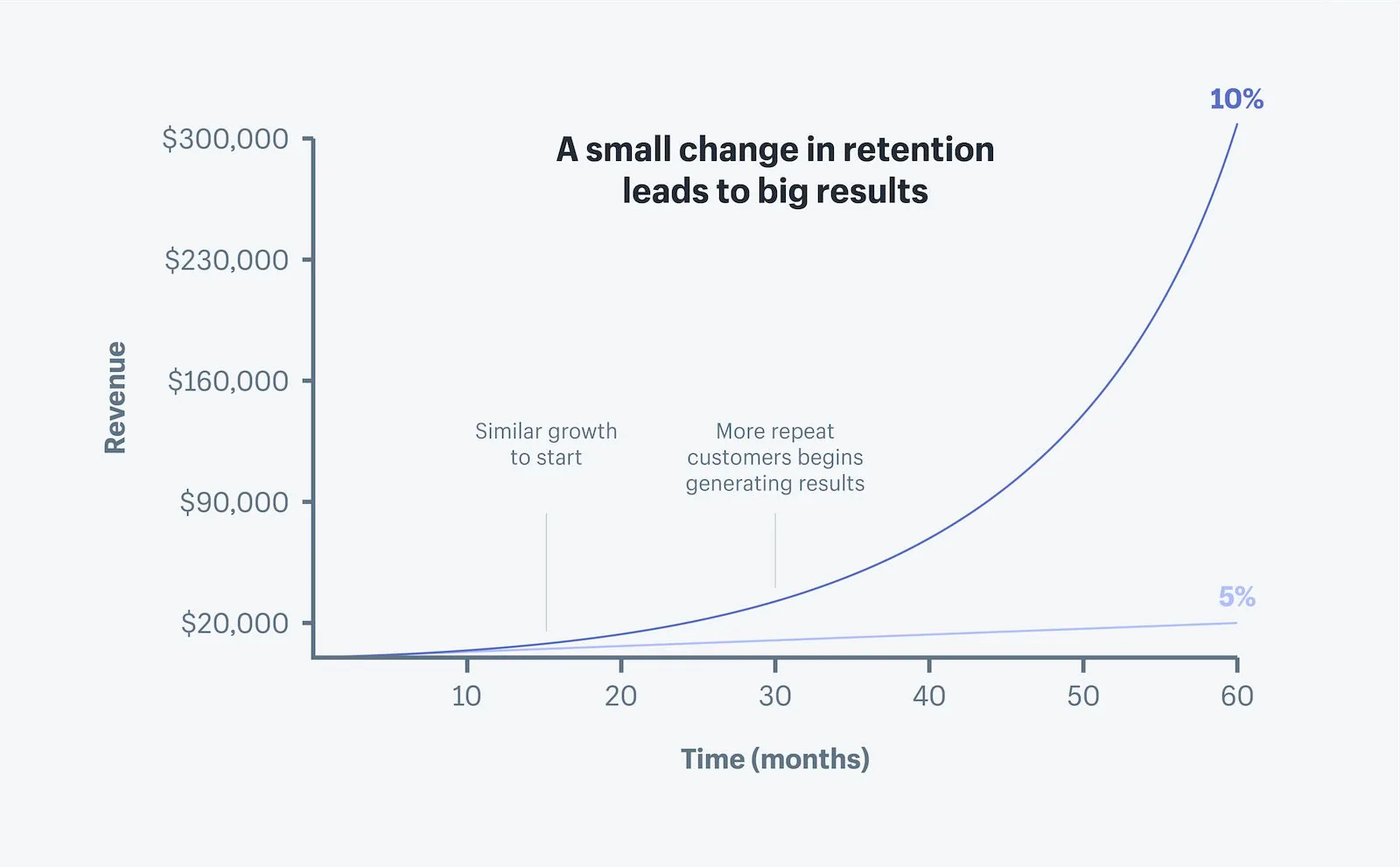
A small increase in retention leads to big results.
Types of win-back campaign
Email marketing is the primary type of communication used in win-back campaigns—largely because it’s easy for merchants to connect email addresses with customer data entered throughout the checkout process.
Assuming the average email conversion rate is 0.1% and your store’s AOV is $40, sending a win-back campaign to a list of 10,000 subscribers could drive $40,000 in otherwise lost revenue.
Win-back campaigns can expand beyond the inbox and retarget past customers through:
-
SMS. The majority of people have notifications enabled for text messages, contributing to an average SMS open rate of 98%. Merchants using Yotpo’s SMSBump feature reportedly see 11% conversion rates or higher on this type of win-back message.
-
Push notifications. Reach customers who’ve previously paid using Shop Pay through in-app push notifications that make them aware of new products, discounts, or promotions.
-
Paid advertising. Platforms like Facebook, Instagram, and Google Shopping allow merchants to retarget previous customers. Upload your customer lists within each advertising dashboard and convince customers who haven’t purchased in a while to return.
How to create a win-back email series
What to include in a win-back campaign
A win-back campaign typically consists of four elements—starting with an initial reengagement email and continuing with feedback, incentives, and a last-chance farewell.
Reengagement
A reengagement message is your first check-in with an inactive customer. Since these subscribers likely haven’t interacted with your brand in weeks, open the door to conversion by telling them what they’ve missed.
New stock alerts, bestselling products, or seasonal sales perform great in the first part of your win-back campaign. Inactive subscribers see what they’ve missed, and the innate social proof that comes alongside a “bestseller” label induces the fear of missing out—a psychological phenomenon that influences 60% of people to buy.
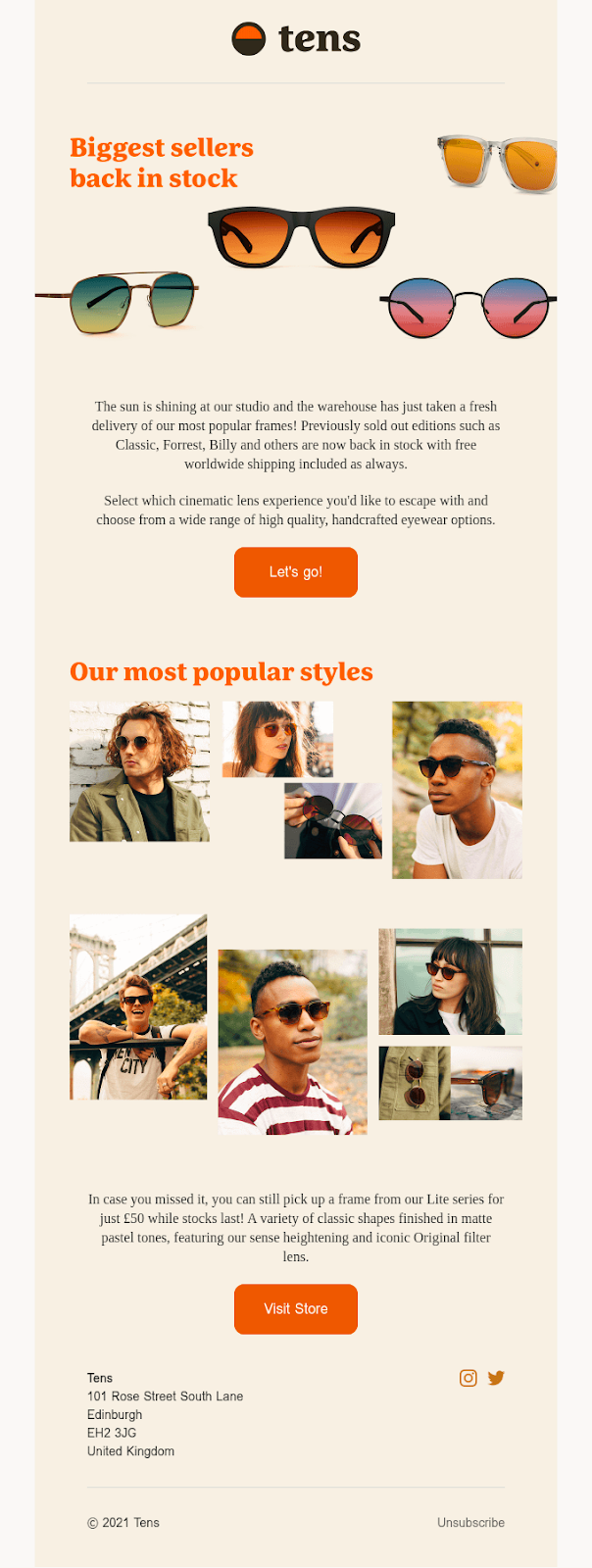
Tens reintroduces customers to its brand by rounding up its bestselling sunglasses. Source: Really Good Emails
Incentive
Not all customers will respond to your win-back campaign by visiting your storefront. Oftentimes, customers who’ve forgotten about your brand need an incentive to revisit your website and purchase again.
Reserving the deal for customers further along in the win-back series prevents you from unnecessarily losing profit on inactive subscribers who only needed a small nudge.
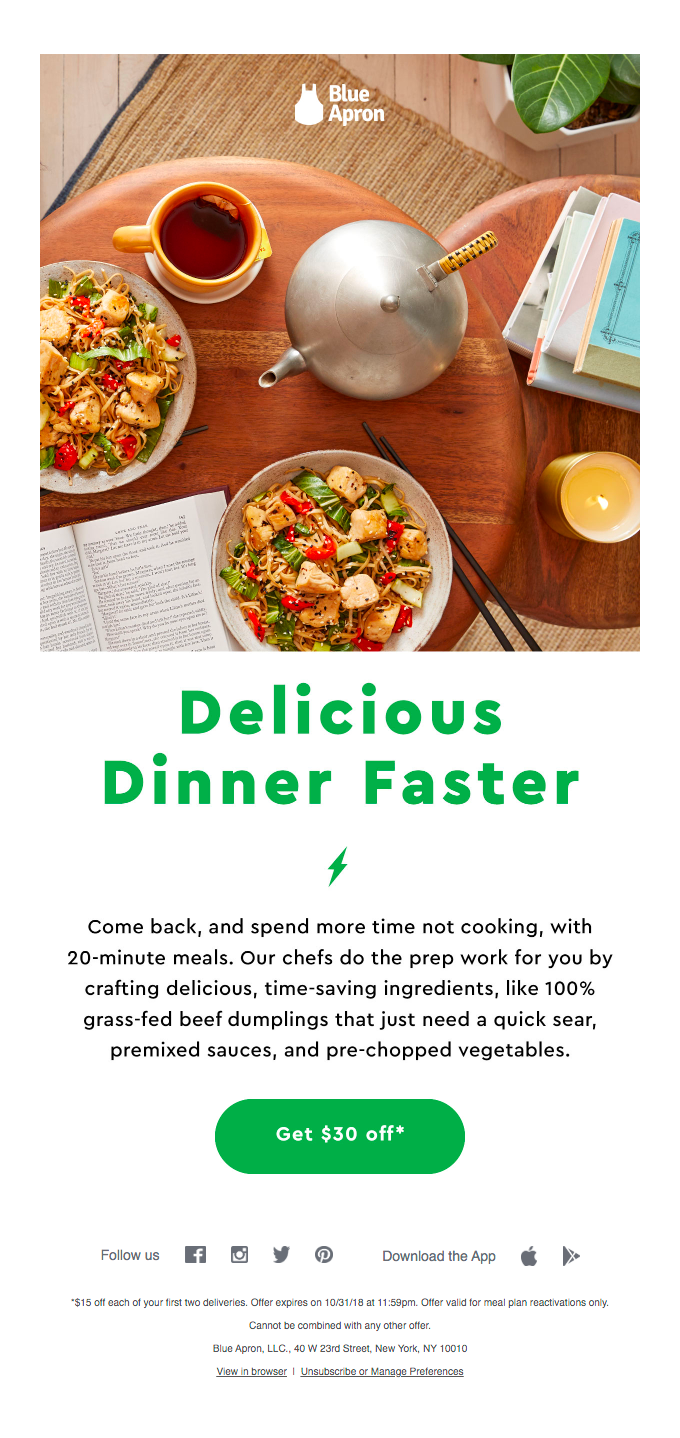
Blue Apron provides customers with $30 credit when they resume a meal prep subscription. Source: Really Good Emails
Feedback
Inactive customers who reach this stage in your win-back series likely have something holding them back. Ask them outright in the hopes a sales rep can ease their pre-purchase anxieties and make another purchase.
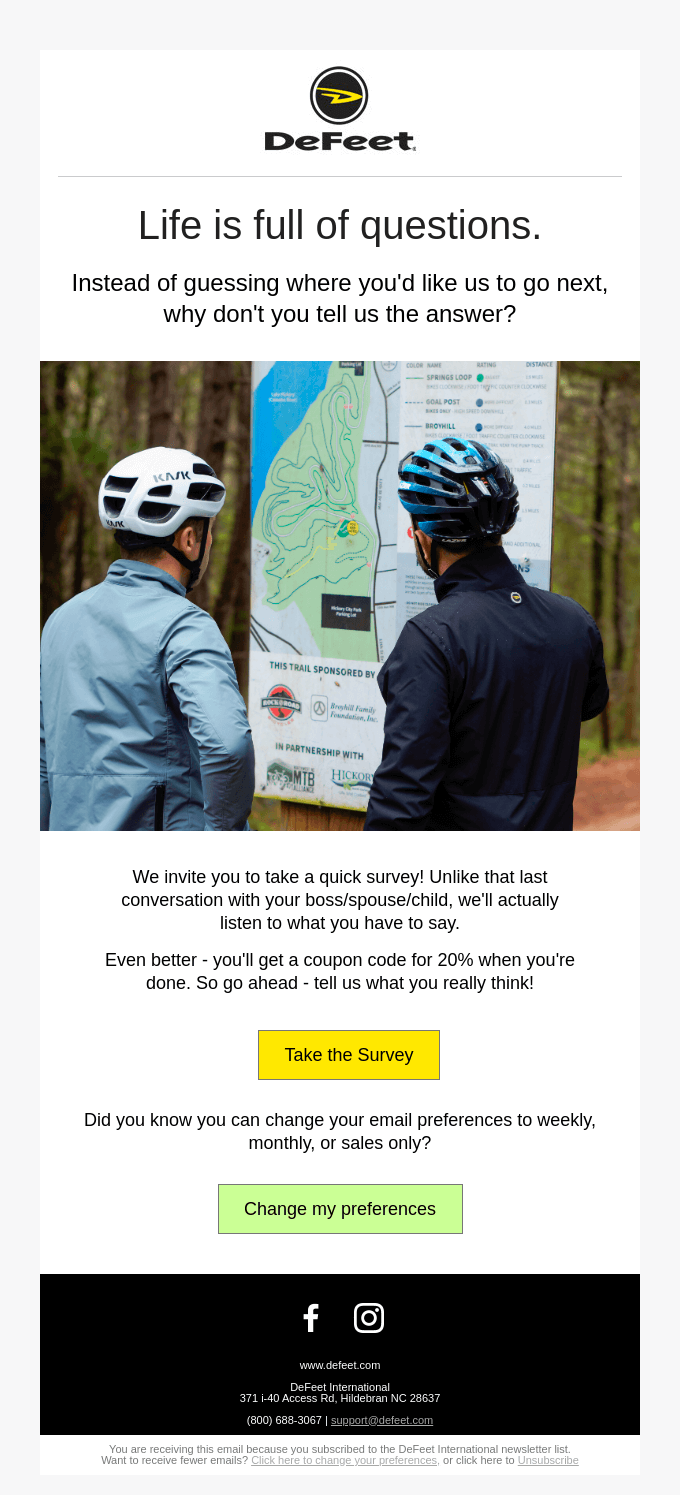
DeFeet sent this email invitation for subscribers to take its survey. Source: Really Good Emails
The added benefit to automated feedback systems is that you can use them for other purposes, too. How about contacting your other customer groups and asking them how you can help them, or if there are any problems that could possibly make them stop buying from you in the future?
If past customers say they’re more likely to purchase from you if they know renewal subscriptions might make it more convenient for them in the future, highlight subscription boxes in your win-back messaging. If loyal customers say slow delivery speeds cause them to stop purchasing, communicate how ordering before a certain cut-off time guarantees next-day delivery.
Final goodbye
Despite making several attempts to convert an inactive subscriber, by this stage, a conversion is unlikely.
Removing inactive subscribers can improve future email performance. Higher engagement rates improve email deliverability, and costs associated with email marketing will decrease. Do not use your budget to email subscribers who won’t place orders.
But before closing the door altogether, give inactive subscribers one last chance to stay connected—perhaps by clicking a link to show they still want to hear from you, or a better-than-average-discount coupon code.
How to find customers ready for a win-back campaign
Before we can use win-back campaigns to retain otherwise-lost customers, we must first identify the people we’re trying to reach. This is where email list segmentation comes into play.
Define the criteria for customers that are likely to reactivate using the RFM matrix. Segment your existing customers based on:
-
R (recency): how recently your customers made their last purchase
-
F (frequency): how often they typically make repeat orders
-
M (monetary value): the dollar value of their average purchase (AOV)
Start your win-back campaign by prioritizing your highest value customers first—the ones with a high average order size but who haven’t purchased anything for a while. Convincing these people to purchase will result in the most revenue for your brand.
From there, tap into subscribers with a high purchase frequency. Much like your first segment, these were once-loyal customers—only they didn’t spend as much as your high priority group.
Use Shopify Flow to create these segments and feed information through to your email marketing platform, such as Klaviyo or Yotpo. These ecommerce automations tag people who fit your criteria and therefore trigger entry into a win-back campaign.
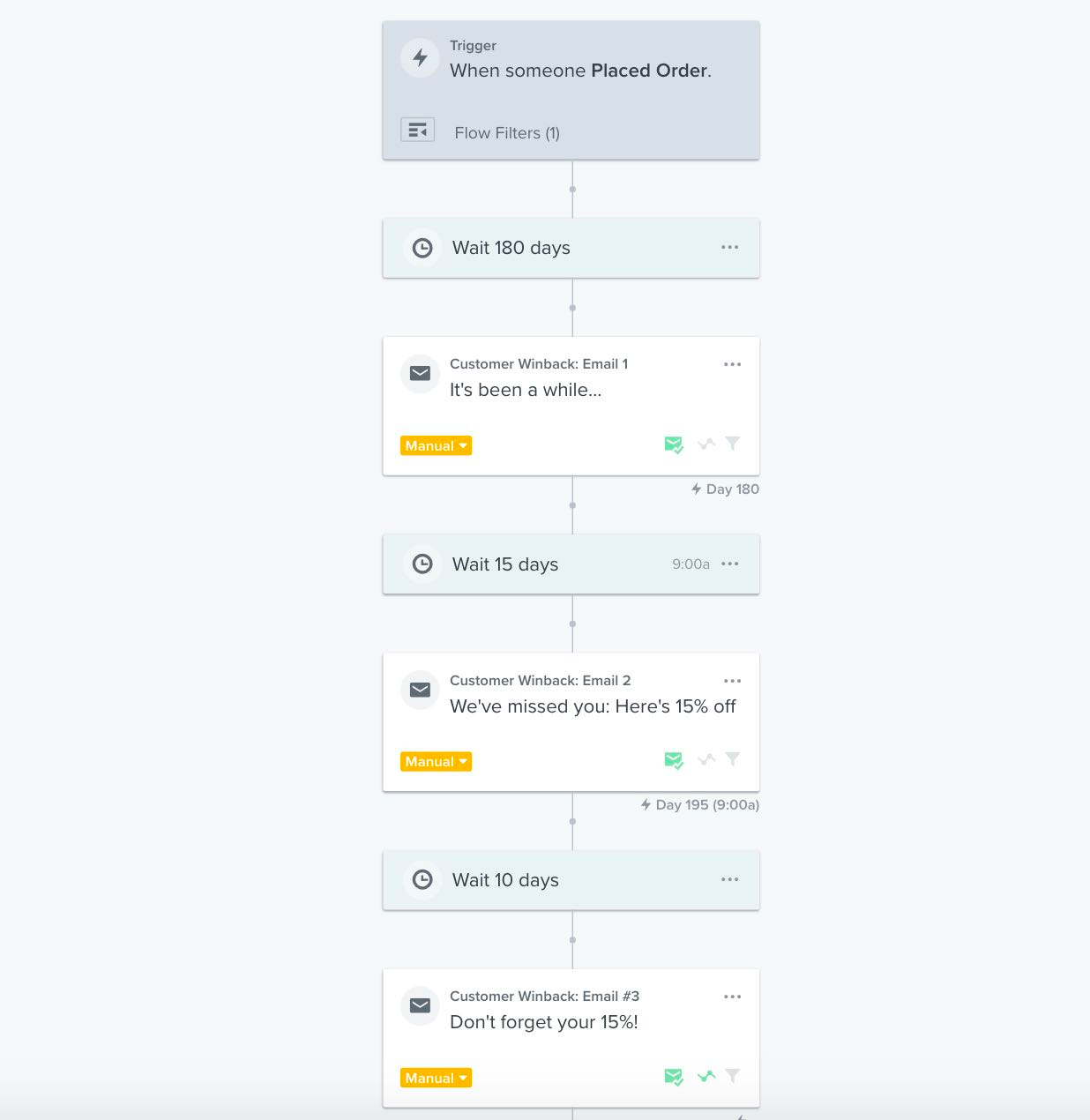
Klaviyo’s win-back email automation.
How to segment post-purchase campaigns
There are endless subgroups within the general group of inactive customers to target going forward. For example, you could use tags inside your email marketing platform to segment people who meet the following criteria:
-
Subscribers who’ve placed more than X orders
-
People who’ve bought a product or from a certain category
-
Those who’ve conducted certain email behaviors, like people who’ve clicked a link in an email within the past month
-
People with specific browsing behavior, like previous customers who haven’t bought recently but have visited your website
Depending on how you’ve set up your store, this and much more (or less) data is available to you and can all be used to your advantage. The more targeted your win-back campaigns are, the better your chances of turning an otherwise-lost subscriber into a loyal customer.
How to measure the success of a win-back campaign
Much like any marketing campaign, measurement is arguably the most important facet of a win-back campaign. By monitoring performance, you can hone-in on elements known to convert inactive subscribers and ditch those that don’t make a difference.
Start with bounce rate—the percentage of email addresses that returned your message. A large gap between a customer’s last order and your win-back campaign can contribute to a high bounce rate. Subscribers might have deleted their email account or accumulated too many emails throughout that time, preventing your message from getting through. Remove hard bounced addresses to improve future deliverability.
Other important metrics to pay attention to when monitoring your win-back campaigns include:
-
Open and click-through rate
-
Unsubscribe rate
-
Conversion rate
-
Revenue generated
-
Repeat order rate
-
Customer lifetime value (CLV)
Break down metrics by campaign type, message, and format for greater insight. Are inactive customers more likely to convert through a free shipping or coupon incentive? Does including this incentive in the subject line improve open rates?
The more granular you can get with each metric, the greater chance you have of identifying conversion opportunities.
Win-back campaign best practices
-
Entice subscribers with the subject line
-
Personalize the incentive
-
Time win-back campaigns around repeat order dates
-
Upsell or cross-sell related products
-
Promote a subscription offer
-
Engage customers elsewhere
Entice subscribers with the subject line
No matter how well-optimized your win-back series is, you’ll have a difficult time converting customers if they don’t open them. This is where your subject line comes into play: almost two-thirds of people decide whether to open an email based on the subject line alone.
Remember: People in your win-back series haven’t purchased in a long time. They may need a reminder about your brand and how you can help them. Meal subscription service Blue Apron communicates this with the subject line “Come on back—we made dinner easier! 😋” in its win-back series.
Other effective approaches to take with your win-back subject lines include:
-
Sentences that provoke an emotional response, such as “We miss you” or “We want you back”
-
Question-based subject lines, such as “Are we on the same page?”
-
Pain-point-specific subject lines, such as “Still struggling with [problem]?”
Personalize the incentive
Incentives play a key role in re-engaging inactive customers. But that doesn’t always mean a cash discount. Other ways to incentivize existing customers to purchase again include:
-
Free shipping over a certain threshold
-
Exclusive product bundles
-
Charitable donations (some 70% of consumers want brands to take a stance on social issues)
Segmentation is the key to a successful win-back campaign. Personalize the incentive for each customer segment in your win-back series.
It’s probably not reasonable to offer a $100 coupon code for a customer who only ordered from your store once. But making the same offer to someone who has bought thousands of dollars worth of merchandise from you before might be the nudge they need to return and place an order you will still generate profit on.
Time win-back campaigns around repeat order dates
Win-back campaigns work best when they’re well-timed. Much like it wouldn’t make sense to enter a subscriber into your win-back series just a few days after purchasing, your campaigns won’t be as effective if you’re emailing customers too late.
Analyze historical sales data and customer feedback surveys to understand how often people tend to replenish your products. If you’re a coffee retailer, for example, ecommerce data analysis might uncover that your coffee packs usually run out within four weeks. Repeat customers place new orders each month.
Schedule your win-back campaigns around these repeat order dates. If someone typically orders a new coffee roast every four weeks but they’re edging on six weeks since their last order, enter them into your win-back series. A subject line like, “Are you running out?” could be enough to entice otherwise-lost customers into purchasing again.
Upsell or cross-sell related products
What happens to your win-back email series if products have a long sales cycle or typically aren’t replenished regularly? Take electronics, for example. People rarely purchase more than one device each year.
A mobile phone retailer shouldn’t wait 12+ months before communicating with its customers. By that point, they could’ve forgotten about the brand entirely, making the elusive win-back harder to make a reality.
Instead, check-in with previous customers and upsell or cross-sell products related to those they’ve already bought before they’re gone. That same mobile phone retailer could recommend phone cases, charging accessories, or clip-on lenses throughout its win-back series.
Not only does it keep the brand top of mind for when they’re looking to upgrade their device, but it’s positioning your company as the go-to provider for phone-related products consumers purchase more frequently than once per year.
Promote a subscription offer
People in your win-back campaign don’t always make repeat purchases just because they’ve fallen out of love with your brand or no longer have a use case for the previous items they’ve bought. Sometimes, customers are lost simply because they forgot.
Forgetfulness strikes in many situations. Perhaps the customer changed their daily routine and forgot how your product slots in. Maybe they intended to make a repeat purchase two weeks ago but were distracted in the process.
Subscriptions combat forgetfulness by taking the pressure off customers to order again. Use them as the foundation for your win-back series and encourage otherwise-lost customers to automatically replenish their favorite items each month—without setting mental reminders (or relying on your marketing campaigns) to do so.
Athletic Greens puts this into practice with its email marketing campaign. It prompts existing customers to “upgrade and continue” their ritual. The main call-to-action isn’t to repurchase the same item, it’s to subscribe to its monthly subscription box and allow the brand to charge their credit card information each month until they cancel.

Athletic Greens’ win-back email pushes subscribers toward a subscription. Source: Really Good Emails
Engage customers elsewhere
Email is the preferred communication channel for almost half of customers.
Yet successful DTC brands connect with customers (including those on the verge of being lost forever) across multiple channels. Some 84% of businesses surveyed in Shopify’s 2023 Ecommerce Trends report said a connected brand experience across several channels will be even more important to commerce than in recent years.
Filter customers approaching the end of your win-back series who haven’t yet purchased. These people either haven’t opened your emails, found the right product, or felt trusting enough to convert.
Instead of unsubscribing them once they reach the end, send a last-ditch attempt to engage with at-risk customers elsewhere. That could mean:
-
Visiting your brick-and-mortar store or retail partner stores
-
Following your brand on social media
-
Opting into SMS messaging
This email from Frontman demonstrates this idea in practice. Customers who haven’t yet purchased a Frontman product but still want to be kept in the loop are notified about its partnership with Urban Outfitters. That way, even though the win-back series doesn’t directly result in a conversion, subscribers still stay within Frontman’s circle of influence.
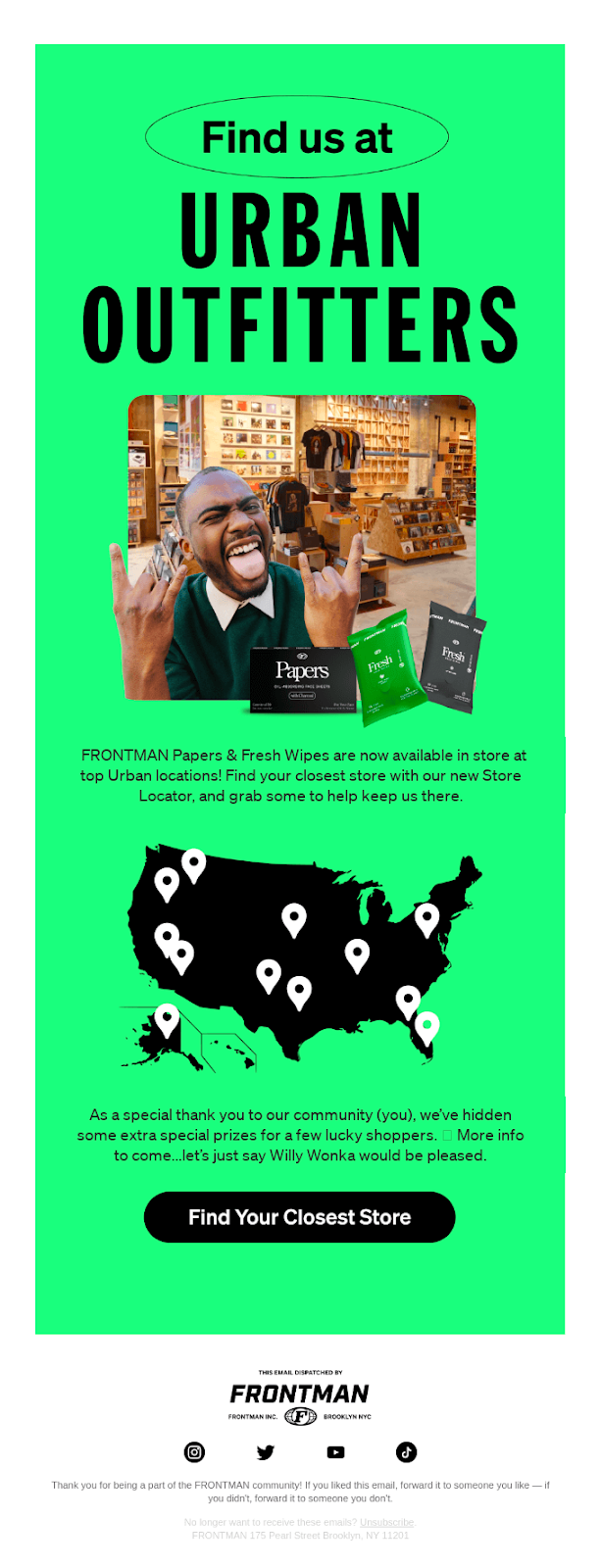
Frontman diverts inactive subscribers toward its retail partner stores. Source: Really Good Emails
Win-back campaign examples
Better Body
Better Body’s email is an example of how time-sensitive emails can be effective in the win-back series. The brand promises its dumbbells are “disappearing for good.” Only customers who order before stock runs out can get the equipment with the coinciding discount.
What’s great about this win-back example is that the limited-stock product drop isn’t used in silo. Inactive subscribers are given subtle nudges to convert elsewhere in the email, like its no-custom-fee promise and buy now, pay later options. High extra fees or upfront payment elements could have deterred one-time customers from purchasing again.

Better Body’s win-back email uses scarcity to push inactive subscribers to buy. Source: Really Good Emails.
Oars + Alps
Men’s skin care brand Oars + Alps doesn’t just rely on emails to win back customers. It uses SMS marketing to reengage customers who haven’t purchased in a while.
The incentive to repurchase in this text is clear: for a limited time, customers can get a mini deodorant kit with any order. People who haven’t placed another order because they didn’t like the scent they chose, for example, get the opportunity to explore new scents and find their favorite.
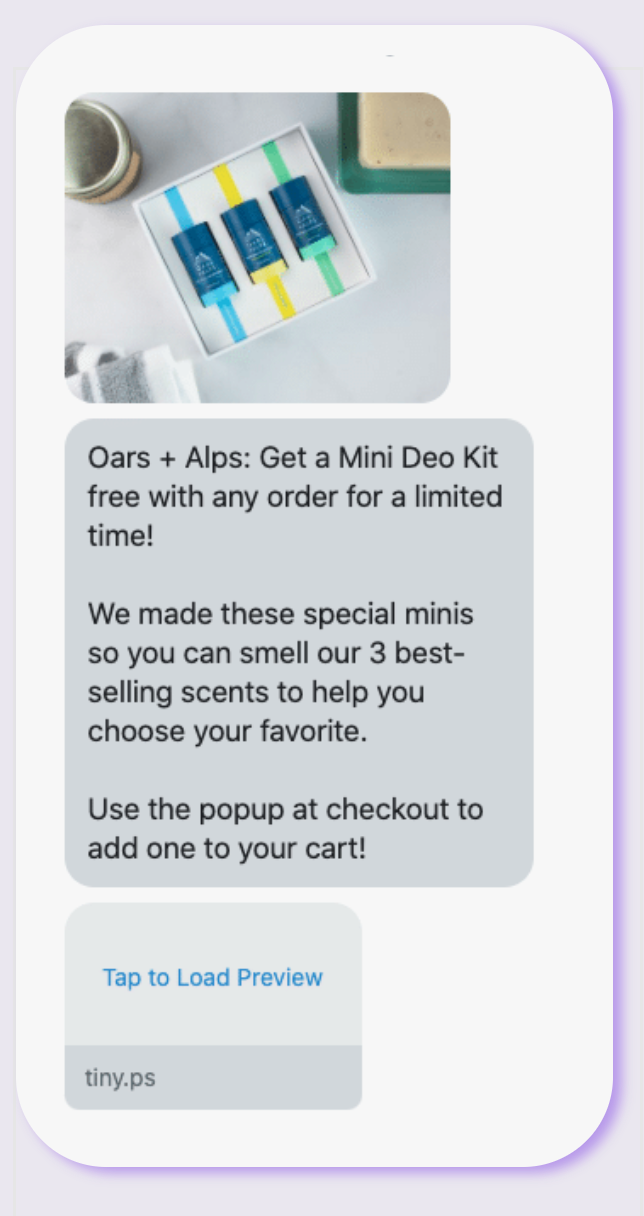
Oars + Alps’ SMS win-back campaign. Source: Fantastic Texts
Our Place
Kitchenware retailer Our Place uses Facebook advertising to communicate with customers. It promotes several short-form videos alongside text that says, “The Always pan got a major upgrade.”
This messaging appeals to inactive customers who haven’t purchased in a while. Say,for example, they weren’t impressed with the quality of the product they last ordered, and that’s why they became inactive. By highlighting the new design and why it’s better, inactive customers have a reason to head back to its ecommerce site and make another purchase.
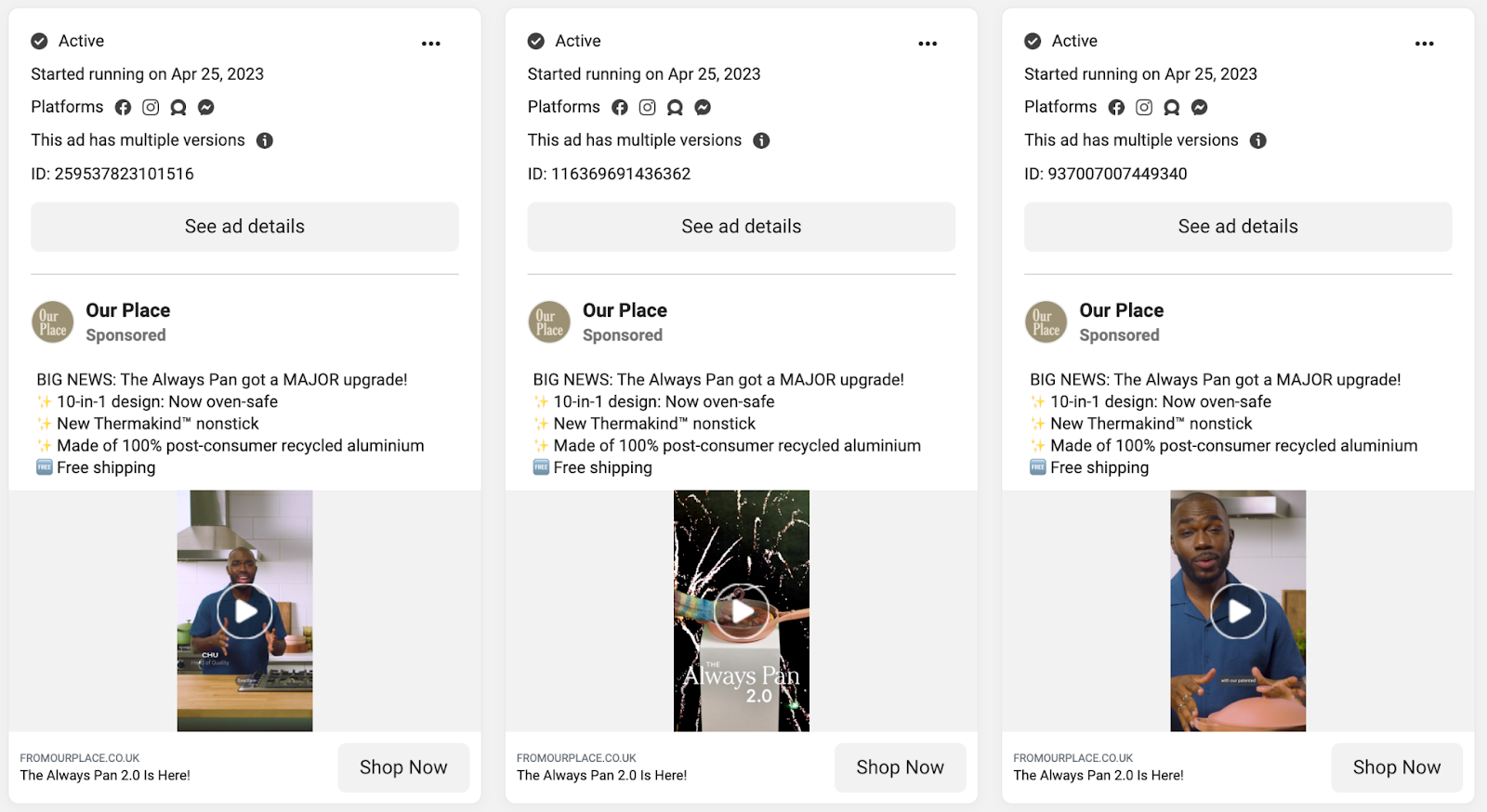
Our Place’s Facebook advertising campaigns that promote new, upgraded products.
Automate your win-back campaigns with Shopify
Your ecommerce platform already houses data about your customers’ buying habits, order size, and more. A few well-timed creative emails could be the difference between losing otherwise-repeat customers and generating predictable revenue for your business.
The best part? Win-back series can be completely automated, making them a no-brainer for any scaling store. Tools like Klaviyo, Omnisend, and Yotpo integrate directly with Shopify, so you can tag any customer at risk of never purchasing again and automatically distribute a high-converting win-back email series that turns them into loyal customers.
Read more
- How to Block the Ad Blockers & Whether You Should
- Instagram Ecommerce Strategy: How to Create an Organic Marketing Plan
- How to Amass +110k Micro-Influencers on Instagram & Increase Referral Sales 300%
- The Master Guide to Google Channel
- New Ecommerce Visitors: How to Serve Up Their Hidden Desires and Pull 'Em into Your Online Funnel
- How to Personalize for Unknown Black Friday Cyber Monday Mobile Visitors
- 5 Ways Brands Grow Revenue Using Text Message Marketing
- “Out of Stock”: How Savvy Ecommerce Directors Create Rock-Solid Merchandise Plans
- Customer Retention: How to Turn New Shoppers into Repeat Customers
- Gift Wrapping in Ecommerce: How to Boost AOV This Holiday Season
Win-back campaign FAQ
What is a win-back campaign?
A win-back campaign is a series of communications between a brand and a previous customer who hasn’t bought recently. Most often, this communication is via email.
What is an example of a win-back campaign?
Blue Apron is a great example of how merchants can use win-back campaigns. Its subject line is “Come on back—we made dinner easier! 😋.” The contents of the email reminds people of the benefits of its meal delivery services, concluding with a coupon code to entice inactive customers to resume their subscription.
What is a win-back email campaign?
A win-back campaign is a series of emails sent to previous customers who haven’t purchased in a long time. The goal is to reeducate them on your products and convince them to buy again.
How do you create a win-back campaign?
-
Identify at-risk customers who haven’t purchased recently.
-
Tag these subscribers in your email marketing platform.
-
Send a reengagement email.
-
Provide an incentive to purchase again.
-
Ask for feedback on why they haven’t bought.


